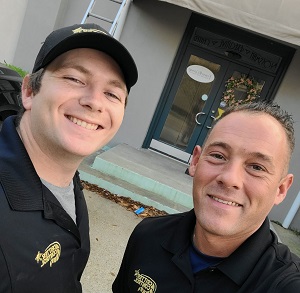Birds aren’t usually considered a pests. But when birds nest or roost on your house or building the nuisance can become a serious problem. Nests can create fire hazards. Their droppings can be dangerous and spread diseases.
There are a few signs that suggest a bird is occupying your interior or exterior living space. By identifying them, you are better equipped to make the best decisions for bird removal.
When you notice those signs, don’t hesitate to contact Critter Control. Our experienced technicians can help you evict your unwanted feathered guests, ensuring your home remains free of bird problems.
Most Common Nuisance Birds in New Orleans
The three common pest birds are pigeons, starlings, and house sparrows.
Pigeons
Pigeons are abundant and look for roosting and nesting spots that resemble the rocks and cliff ledges they prefer. Having pigeons in your yard means you have gutters, chimney ledges, or balconies they enjoy for scoping out the area for food. Pigeons may also use eaves, barns, sheds, or roof vents to build a nest. Pigeon droppings can cause a variety of issues for buildings and people. In addition to being unsightly, the excrement corrodes buildings and kills vegetation when it accumulates in high enough volumes. For a long-term solution to problem pigeons, exclusion is usually an active part of professional bird management. Blocking open spaces on roofs with bird netting or changing the angle of ledges to avoid roosting can help prevent further infestations. Trained technicians can decide the most effective methods for each home or yard.
European Starlings
Starlings are some of the most common pest birds for residential customers. Starlings have bright yellow bills in the summer with a black, iridescent, spot coloring and like to nest in attics through soffit holes (bird block holes). The nests that they build and will use year after year if allowed are big, smelly, toxic, and mite-ridden.
House Sparrows
House sparrows live close to humans. Sparrows regularly take up residence in and around manmade buildings, which contributes to noise pollution as well as various health hazards that result from their droppings. Due to swallows’ social nature, large infestations regularly occur in backyards. Though beneficial in eliminating insects, their presence comes with excessive droppings that mar lawns, sidewalks, and houses. Swallow colonies also deface siding with multiple mud nests.
Other Nuisance Birds
Other birds may occasionally cause unexpected and unusual pest problems. Woodpeckers may peck holes into house siding looking for insects and to make nest cavities. When blackbirds and crows roost in suburban areas they become pests. Seagulls can feed on food plants, and they roost and nest on large flat roofs with crushed stone.
Most bird species have strict regulations on what types of control methods you can use. The most effective bird removal services are harassment techniques. These control methods make the habitat less inviting to birds so they find another roosting location.
Commercial Bird Control Solutions
Bird Netting
An exclusion material is typically installed as a horizontal ceiling or vertical wall barrier to deny birds access to enter a space, or roost on a structure. Heavy-duty UV-stabilized polyethylene netting is suspended utilizing a high-tension steel perimeter cable and turnbuckle system. Zippers are installed in the netting to provide maintenance access for lights and other similar fixtures.
Bird Electric Track
A humane deterrent product adhered to ledges, signage and roofs to deter birds from roosting on the surface. A flexible UV-stabilized PVC base, with electrically charged contacts, provides a mild-electrical sensation to modify the birds’ habits and encourage them to roost elsewhere. Electric Track may also be installed in non-typical locations to deter birds and other wildlife.
Bird Slide
An exclusion product is typically installed on a flat surface to deter birds from roosting on ledges, windowsills or structural beams. The angled material effectively raises the pitch of the ledge surface to approximately 45 degrees, creating a surface bird cannot land on. Bird Slide may also be used in other unique situations to control birds and other wildlife.
Bird Wire
A humane deterrent system is installed on ledges, pipes, ridges, gutters, windowsills, and structural beams to deter birds from roosting. A series of stainless-steel posts spanning spring-tensioned wires create an unsteady landing and roosting surface for approaching birds.
Bird Gel
A humane repellant is typically applied to ledges, architectural trim, windowsills and structural beams to deter birds from roosting. Applied directly to a surface or distributed in a series of gel dishes, this multi-sensory bird deterrent helps repel birds and modify their behavior to go elsewhere.
Bird Spikes
A deterrent for medium-size to large-size birds fastened to horizontal surfaces, such as ledges, pipes, windowsills, and structural beams to deter birds from roosting. Rows of metal or plastic spikes, connected to a base are attached to the surface to be protected from birds.
